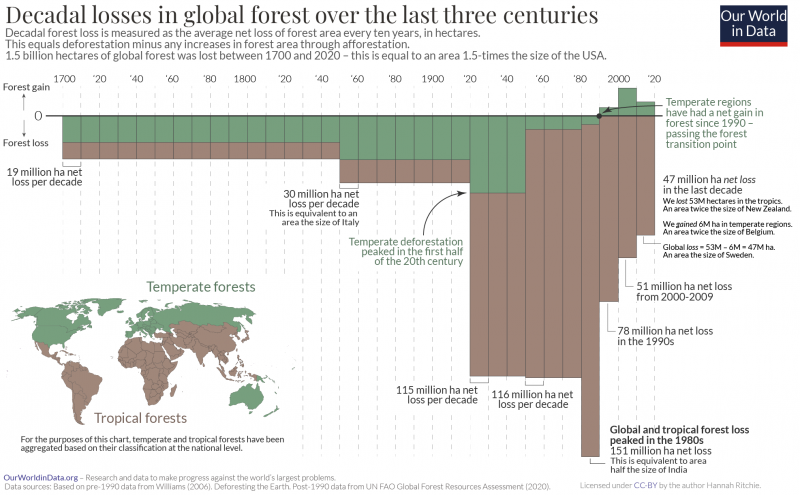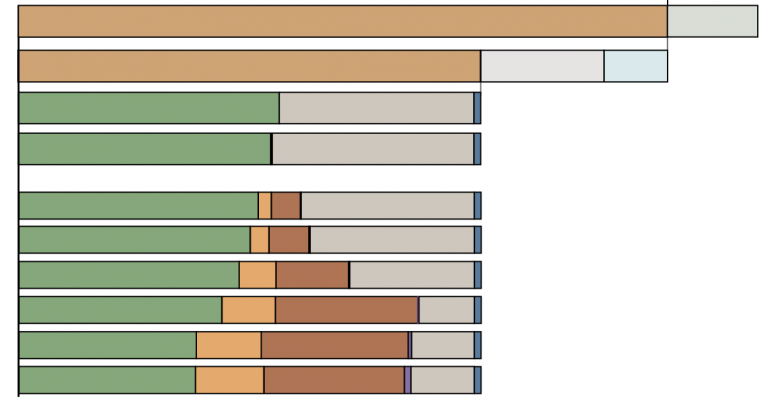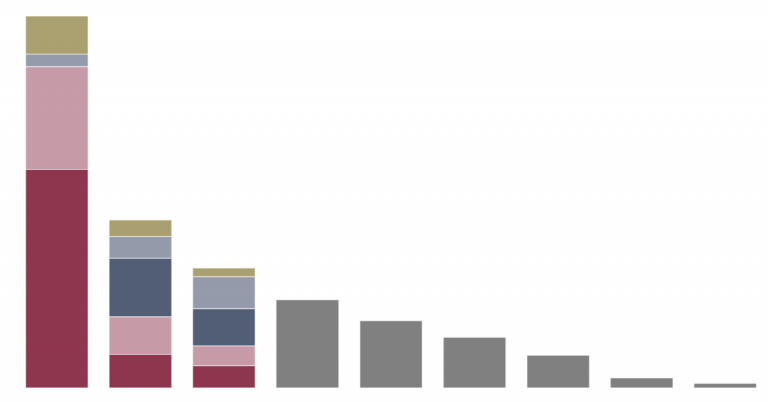Summary
The world has lost one-third of its forests since the end of the last great ice age. Deforestation has continued throughout the last millennia but rates rapidly accelerated in the last few centuries. There was a marked acceleration in deforestation rates in the 20th century, particularly in tropical regions. Global forest loss peaked in the 1980s – losing an area half the size of India. Since then, deforestation has slowed. In fact, many countries have now reversed the long-term trend and transitioned to a net gain of forests, reforestation.
Since the end of the last great ice age – 10,000 years ago – the world has lost one-third of its forests.1 Two billion hectares of forest – an area twice the size of the United States – has been cleared to grow crops, raise livestock, and use for fuelwood.
In a previous post we looked at this change in global forests over the long-run. What this showed was that although humans have been deforesting the planet for millennia, the rate of forest loss accelerated rapidly in the last few centuries. Half of global forest loss occurred between 8,000BC and 1900; the other half was lost in the last century alone.
To understand this more recent loss of forest, let’s zoom in on the last 300 years. The world lost 1.5 billion hectares of forest over that period. That’s an area 1.5-times the size of the United States.
In the chart we see the decadal losses and gains in global forest cover. On the horizontal axis we have time, spanning from 1700 to 2020; on the vertical axis we have the decadal change in forest cover. The taller the bar, the larger the change in forest area. This is measured in hectares, which is equivalent to 10,000 m².
Forest loss measures the net change in forest cover: the loss in forests due to deforestation plus any expansion of forest through afforestation.2
To reconstruct this change I have brought together the data from a number of different sources.3 We’ve also differentiated between temperate forests (the sum of ‘boreal’ and ‘temperate’ areas), shown in green, and tropical forests (the sum of ‘tropical’ and ‘subtropical’ areas), shown in brown. It’s useful to make this distinction because – as we will see – where the world has lost forests has shifted.
The rate of forest loss changed a lot. From 1700 to 1850, 19 million hectares were being cleared every decade. That’s around half the size of Germany. From 1850 to 1920, losses were around 50% higher at 30 million hectares per decade –that’s like losing a forested area the size of Italy every 10 years. It was predominantly temperate forests that were being lost at this time. Population growth meant that today’s rich countries across Europe and North America needed more and more resources such as land for agriculture, wood for energy, and for construction.4
Moving into the 20th century there was a stepwise change in demand for agricultural land and energy from wood. Deforestation rates accelerated. From the 1920s through to the 1980s, decadal losses quadrupled to almost 120 million hectares. That’s equivalent to the area of South Africa. This increase was mostly driven by tropical deforestation as countries across Asia and Latin America followed the path of Europe and North America.
Global deforestation reached its peak in the 1980s. We lost 150 million hectares – an area half the size of India – during that decade. Clearing of the Brazilian Amazon for pasture and croplands was a major driver of this loss.
Since then, deforestation rates have steadily declined, to 78 million hectares in the 1990s; 52 million in the early 2000s; and 47 million in the last decade.
As we explore in more detail in our related article, countries tend to follow a predictable development in forest cover, a U-shaped curve.5 They lose forests as populations grow and demand for agricultural land and fuel increases, but eventually they reach the so-called ‘forest transition point’ where they begin to regrow more forests than they lose.
Within this global aggregated trend there are many forest transitions at local, national or regional levels occurring. We see one such transition in the chart: the forest loss in the temperate regions – shown as the green part of the bars – peaked much earlier than the global forest loss. In the first half of the 20th century, temperate forests reached their peak loss at 34 million hectares per decade, and by 1990 they had passed the ‘forest transition point’. For the past 30 years, temperate regions have seen a continued increase in forest cover through afforestation: you see this as the bars are now ‘positive’ (pointing upwards). Across temperate forests the world gained 6 million hectares in the last decade.
Tropical forests, on aggregate, have also passed peak deforestation in the 1980s – the longest of all bars – but have not passed the transition to reforestation. Some countries within this group are still far behind peak deforestation: without concerted effort to protect these forests it could be many decades before forests in those countries approach the transition point [as we show in a related post].6
The history of deforestation is a tragic one, in which we not only lost these wild and beautiful landscapes but also the wildlife within them. But, the fact that forest transitions are possible should give us confidence that a positive future is possible. Many countries have not only ended deforestation, but actually achieved substantial reforestation. It will be possible for our generation to achieve the same on the global scale and bring the 10,000 year history of forest loss to an end.
If we want to end deforestation we need to understand where and why it’s happening; where countries are within their transition; and what can be done to accelerate their progress through it. We need to pass the transition point as soon as possible, while minimising the amount of forest we lose along the way.

These are the questions we explore in our series of articles on this topic.

